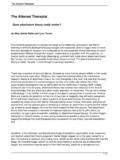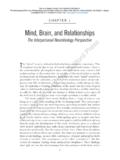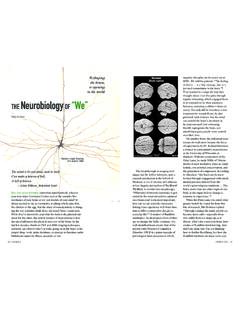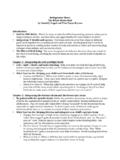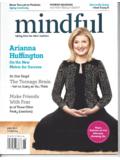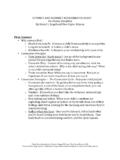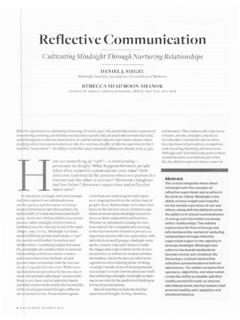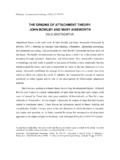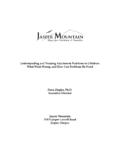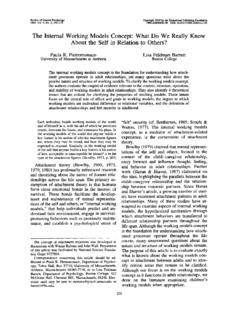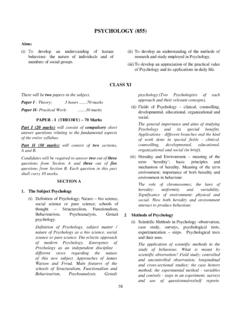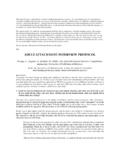Transcription of The Verdict Is In - Dr. Dan Siegel
1 The Verdict Is InThe Verdict Is In The case for attachment theory By Alan Sroufe and Daniel Siegel While many schools of psychotherapy have held that our early experiences with our caretakershave a powerful impact on our adult functioning, there have been plenty of hard-nosedacademics and researchers who've remained unconvinced. Back in 1968, psychologist WalterMischel created quite a stir when he challenged the concept that we even have a corepersonality that organizes our behavior, contending instead that situational factors are muchbetter predictors of what we think and do.
2 Some developmental psychologists, like Judith RichHarris, author of The Nurture Assumption, have gone so far as to argue that the only importantthing parents give their children is their genes, not their care. Others, like Jerome Kagan, haveemphasized the ongoing influence of inborn temperament in shaping human experience,asserting that the effect of early experience, if any, is far more fleeting than is commonlyassumed. In one memorable metaphor, Kagan likened the unfolding of life to a tape recorderwith the record button always turned on and new experiences overwriting and erasing previousexperiences.
3 N At the same time, the last 50 years have seen the accumulation of studiessupporting an alternative view: the idea that the emotional quality of our earliest attachmentexperience is perhaps the single most importantinfluence on human development. The central figure in the birth of this school of research hasbeen British psychiatrist and psychoanalyst John Bowlby, who challenged the Freudian view ofdevelopment, claiming that it had focused too narrowly on the inner world of the child withouttaking into account the actual relational environment that shapes the earliest stages of humanconsciousness.
4 Bowlby's thinking was influenced by his study of how other mammals rear their young, and thedistinctive core of his contribution to developmental psychology may be traced to a very simpleobservation: whereas young ground-dwelling animals run to a place of protection whenfrightened, primates like chimpanzees and gorillas run to a protective adult, who then carriesthem to safety. As he focused on the developmental significance of this survival pattern, Bowlbyconcluded that humans the most dependent of mammal infants are wired like their primatecousins to form attachments, because they couldn't survive without them.
5 But Bowlby went further. While agreeing with his psychoanalytic colleagues that earlyexperiences with our caretakers are crucial to the people we become, he made an importantdistinction. Infants are attached to their caregivers not because caregivers feed them, but 1 / 12 The Verdict Is Inbecause caregivers trigger the unfolding of infants' inborn disposition to seek closeness with aprotective other. By divorcing human attachment from the drive-reduction notions of Freudiantheory, Bowlby laid the foundation for a shift from seeing people as individuals somehowstanding apart from their social environment to a more fine-tuned grasp of just how deeplyrelational human nature is.
6 The Challenge of Measuring Relationships Bowlby's theory can be boiled down to two propositions: the history of children's interactionswith early caretakers shapes the quality of their attachment relationships (whether they becomesecure); and, these attachment relationships then become the foundation for later personalitydevelopment. But for theory and speculation to truly become science, there must a means ofmeasurement, something that Freud and his successors had largely ignored. The practicalchallenge for researchers testing Bowlby's propositions about development was to find amethod for capturing something seemingly elusive.
7 After all, how can you possibly measure a relationshipto determine whether it's affecting a child's development? While it's relatively easy to measure how often an infant seeks contact, or whether it cries whensomeone approaches, none of these factors really capture the quality of the connection theyoung child experiences. If secure attachment isn't an inborn trait but a quality of therelationship that's being examined, how is this to be defined and measured? The answer to thatquestion has been the key to the growth of the attachment -research literature, and the credit fordevising a way to measure attachment goes largely to Mary Ainsworth.
8 A colleague of Bowlby'sat the Tavistock Institute, Ainsworth went on to conduct a series of field observations, first inUganda and then in Baltimore, which ultimately led to the Strange Situation laboratoryprocedure. While in Uganda, Ainsworth first developed the hypothesis that "attunement," the sensitiveresponsiveness to the infant's cues, was the critical factor in determining the type and quality ofan infant's attachment , not simply a generalized trait like "warmth." Vigorously playing with analready overly aroused infant wouldn't be attuned parental behavior, while engaging in the samebehavior with an infant who needs such stimulation would have a very different relationalmeaning.
9 Attunement, or sensitivity, requires that the caregiver perceive, make sense of, andrespond in a timely and effective manner to the actual moment-to-moment signals sent by thechild. 2 / 12 The Verdict Is In Later, while at Johns Hopkins University in Baltimore, Ainsworth tested her ideas aboutattachment patterns by putting in 47 hours of painstaking observation with each mother childpair in her study. She found that when caregivers promptly and effectively responded to younginfants' cries, the babies cried less by the end of the first year.
10 The securely attached childrenhad learned that their caregivers were reliable and therefore subtler expressions of their distressand needs would generate responses they didn't need to be crybabies to get the attention theysought. Infants who develop confidence in their caregivers are securely attached because theircaregivers have proven to be reliable. To create a more practical lab method that wouldn't require so many hours of extendedobservation, Ainsworth developed the Strange Situation procedure as a way of going beyondmeasures of simple infant behaviors to capture qualities of the mother-child relationship.
